Weight Management Packaged Food Market
Weight Management Packaged Food Market Size and Share Forecast Outlook 2025 to 2035
Weight management packaged food market is projected to grow from USD 7.2 billion in 2025 to USD 12.6 billion by 2035, at a CAGR of 5.9%. Meal replacement bars/shakes will dominate with a 54.0% market share, while functional/high-protein will lead the by claim segment with a 42.0% share.
Weight Management Packaged Food Market Forecast and Outlook 2025 to 2035
The global weight management packaged food market is projected to grow from USD 7.2 billion in 2025 to approximately USD 12.6 billion by 2035, recording an absolute increase of USD 5.4 billion over the forecast period. This translates into a total growth of 75.0%, with the market forecast to expand at a CAGR of 5.9% between 2025 and 2035.
The overall market size is expected to grow by nearly 1.8 times during the same period, supported by increasing global obesity awareness, growing adoption of structured weight management solutions in consumer lifestyles, and rising health consciousness driving premium weight management food procurement across various consumer segments.
Quick Stats for Weight Management Packaged Food Market
| Weight Management Packaged Food Market Value (2025) | USD 7.2 billion |
|---|---|
| Weight Management Packaged Food Market Forecast Value (2035) | USD 12.6 billion |
| Weight Management Packaged Food Market CAGR | 5.9% |
| Leading Segment by Product (2025) | Meal replacement bars/shakes (54.0%) |
| Leading Segment by Claim (2025) | Functional/high-protein (42.0%) |
| Leading Segment by Channel (2025) | Retail (61.0%) |
| Key Growth Regions | North America, Europe, and Asia Pacific |
| Top Companies by Market Share | Herbalife, Nestlé, Abbott |
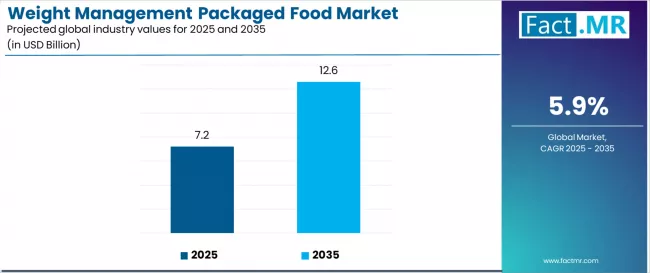
Weight Management Packaged Food Market Key Takeaways
| Metric | Value |
|---|---|
| Market Value (2025) | USD 7.2 billion |
| Market Forecast Value (2035) | USD 12.6 billion |
| Forecast CAGR (2025-2035) | 5.9% |
Why is the Weight Management Packaged Food Market Growing?
| HEALTH & WELLNESS TRENDS | LIFESTYLE MANAGEMENT REQUIREMENTS | REGULATORY & QUALITY STANDARDS |
|---|---|---|
| Global Obesity Awareness Growth | Sophisticated Nutrition Requirements | Food Safety Standards |
| Continuous expansion of obesity awareness across established and emerging markets driving demand for structured weight management solutions. | Modern lifestyle management requires convenient packaged foods delivering precise caloric control and enhanced satiety benefits. | Regulatory requirements establishing safety benchmarks favoring high-quality weight management food systems. |
| Structured Diet Recognition | Convenience Demands | Nutritional Labeling Standards |
| Growing focus on structured weight loss programs and meal replacement systems creating demand for specialized packaged food products. | Consumers investing in convenient nutrition solutions offering consistent performance while maintaining busy lifestyle compatibility. | Quality standards requiring superior nutritional profiles and accurate caloric declarations in weight management products. |
| Premium Health Positioning | Quality and Efficacy Standards | Health Claim Compliance Requirements |
| Superior convenience and portion control characteristics making weight management packaged foods essential for structured diet programs. | Certified manufacturers with proven nutritional profiles required for weight management and meal replacement applications. | Diverse regulatory requirements and health claim standards driving need for scientifically-validated weight management solutions. |
Weight Management Packaged Food Market Segmentation
| Category | Segments Covered |
|---|---|
| By Product | Meal replacement bars/shakes, Low-calorie ready meals, Snacks |
| By Claim | Clinically formulated, Functional/high-protein, Low-calorie |
| By Channel | Retail, Online subscription, Clinical distribution |
| By Region | North America, Europe, Asia Pacific, Latin America, Middle East & Africa |
Weight Management Packaged Food Market Analysis by Product
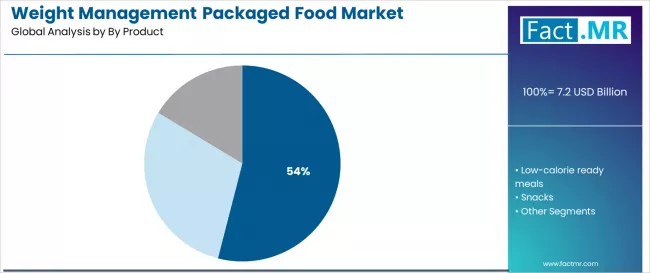
| Segment | 2025 to 2035 Outlook |
|---|---|
| Meal replacement bars/shakes | Leader in 2025 with 54.0% market share; likely to maintain leadership through 2035. Superior convenience factor, proven nutritional control, and established consumer acceptance in weight management programs. Momentum: strong growth driven by structured diet trends and busy lifestyle demands. Watchouts: taste optimization challenges, ingredient cost inflation. |
| Low-calorie ready meals | Strong segment with 28.0% share due to comprehensive meal solutions and portion control benefits. Benefits from convenience positioning and complete nutrition delivery. Momentum: moderate growth through 2030, supported by convenience food expansion and calorie-conscious dining. Watchouts: fresh food competition, cold chain requirements. |
| Snacks | Represents 18.0% market share, encompassing protein bars, portion-controlled snacks, and between-meal options with weight management positioning. Growing interest in healthy snacking and portion control solutions. Momentum: selective growth in healthy snacking and portion control segments. Innovation-dependent with taste optimization and satiety enhancement requirements. |
Weight Management Packaged Food Market Analysis by Claim
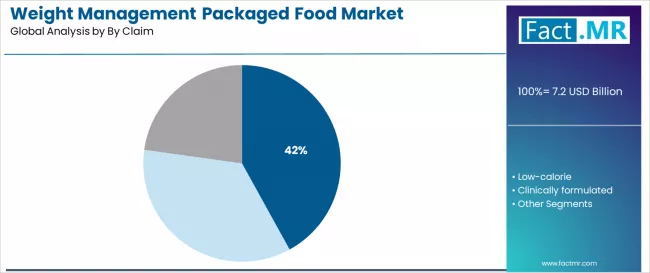
| Segment | 2025 to 2035 Outlook |
|---|---|
| Functional/high-protein | Leading segment with 42.0% market share, focusing protein content for muscle maintenance and satiety enhancement during weight management. Benefits from fitness culture integration and nutritional science validation. Momentum: strong growth driven by protein awareness and fitness lifestyle trends. Watchouts: protein source costs, digestibility optimization challenges. |
| Clinically formulated | Strong segment with 36.0% share, focused on medically-supervised weight management programs and clinical validation. Premium positioning with healthcare professional endorsement and scientific backing. Momentum: moderate growth via medical weight management programs and professional recommendations. Watchouts: regulatory complexity, clinical evidence requirements. |
| Low-calorie | Represents 22.0% market share, fundamental positioning for calorie-conscious consumers and basic weight management needs. Established market approach with broad consumer appeal. Momentum: steady growth in traditional weight management but declining share as functional claims gain preference. Innovation-dependent with taste and satisfaction optimization needs. |
Weight Management Packaged Food Market Analysis by Channel
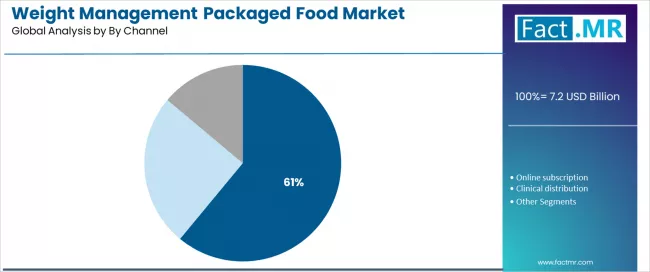
| Segment | 2025 to 2035 Outlook |
|---|---|
| Retail | Dominant segment with 61.0% market share, encompassing supermarkets, health stores, and specialty nutrition retailers providing convenient access to weight management foods. Established distribution networks with broad consumer reach. Momentum: steady growth driven by retail expansion and health food category development. Watchouts: shelf space competition, margin pressure from retailers. |
| Online subscription | Growing segment with 25.0% share driven by personalized nutrition programs and direct-to-consumer business models. Benefits from convenience, customization, and higher customer lifetime value. Momentum: strong growth through 2030, supported by e-commerce expansion and personalized nutrition trends. Watchouts: customer acquisition costs, subscription model sustainability. |
| Clinical distribution | Specialized segment with 14.0% share, focused on medical weight management programs and healthcare provider recommendations. Premium positioning with professional oversight and clinical validation. Momentum: selective growth in medical weight management and obesity treatment programs. Innovation-dependent with clinical evidence requirements and professional endorsement needs. |
DRIVERS
| DRIVERS | RESTRAINTS | KEY TRENDS |
|---|---|---|
| Global Obesity Crisis Growth | Taste and Satisfaction Challenges | Personalized Nutrition Technologies |
| Continuing expansion of obesity awareness across established and emerging markets driving demand for structured weight management solutions. | Consumer acceptance challenges related to taste, texture, and meal satisfaction affecting long-term adherence and repeat purchase rates. | Integration of genetic testing, metabolic profiling, and customized meal planning systems enabling superior personalization and effectiveness. |
| Structured Diet Recognition | Cost Premium Acceptance | Plant-Based Formulation Innovation |
| Increasing recognition of structured weight management programs effectiveness driving demand for convenient and reliable meal replacement solutions. | Premium pricing of weight management foods compared to regular meals affecting adoption in price-sensitive consumer segments. | Enhanced plant-based protein sources, sustainable packaging, and allergen-free formulations compared to traditional meal replacement systems. |
| Premium Convenience Positioning | Regulatory Complexity | Digital Integration Platforms |
| Growing demand for foods that support both weight management goals and busy lifestyle requirements in modern consumer behavior. | Complex regulatory requirements for health claims and weight management products affecting product development and marketing approaches. | Development of app-connected tracking, progress monitoring, and digital coaching integration providing enhanced user engagement and program compliance. |
Analysis of Weight Management Packaged Food Market by Key Countries
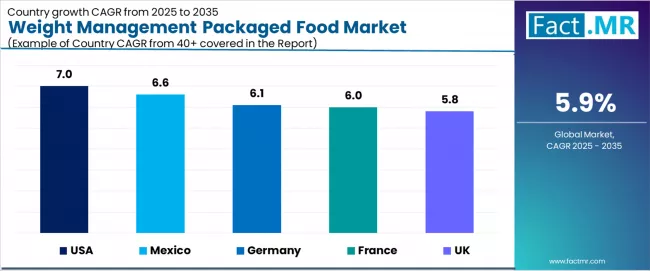
| Country | CAGR (2025-2035) |
|---|---|
| USA | 7.0% |
| Germany | 6.1% |
| France | 6.0% |
| Mexico | 6.6% |
| UK | 5.8% |
USA Leads Global Market Growth with Health Innovation Excellence
The USA is projected to exhibit strong growth with a market value of USD 4.2 billion by 2035, driven by expanding health and wellness industry infrastructure and comprehensive obesity management programs creating substantial opportunities for food suppliers across retail channels, direct-to-consumer platforms, and clinical weight management sectors. The country's established fitness culture and expanding personalized nutrition capabilities are creating significant demand for both meal replacement and functional weight management foods. Major nutrition companies and food manufacturers including Herbalife, specialized suppliers, and health food producers are establishing comprehensive distribution networks to support large-scale consumer operations and meet growing demand for convenient weight management solutions.
- Health and wellness industry modernization programs are supporting widespread adoption of advanced weight management food systems across retail operations, driving demand for high-quality nutritional products
- Obesity management initiatives and structured diet program development are creating substantial opportunities for food suppliers requiring proven effectiveness and consumer satisfaction solutions
- Personalized nutrition advancement and digital health programs are facilitating adoption of specialized weight management technologies throughout major consumer markets
Germany Demonstrates Strong Market Potential with Wellness Innovation Growth
Germany is expanding to reach USD 1.8 billion by 2035, supported by extensive health industry modernization and comprehensive wellness program development creating sustained demand for reliable weight management solutions across diverse consumer categories and health food segments. The country's advanced nutrition science position and expanding health-conscious demographics are driving demand for food solutions that provide consistent nutritional performance while supporting comprehensive wellness requirements. Food manufacturers and nutrition suppliers are investing in local product development facilities to support growing consumer operations and wellness innovation demand.
- Wellness industry operations expansion and health-conscious demographic development are creating opportunities for weight management solutions across diverse consumer segments requiring reliable effectiveness and comprehensive nutrition profiles
- Health technology modernization and nutrition advancement are driving investments in food supply chains supporting weight management requirements throughout major consumer regions
- Research and development programs for nutrition innovation are enhancing demand for precision-formulated weight management systems throughout German consumer markets
France Maintains Leadership with Culinary Wellness Innovation
France is projected to reach USD 1.6 billion by 2035, supported by the country's leadership in culinary arts and advanced wellness systems requiring sophisticated weight management foods for premium lifestyle applications and culinary-focused diet programs. French consumers are adopting high-quality food systems that support culinary satisfaction, nutritional excellence, and comprehensive wellness standards. The market is characterized by focus on culinary quality, natural ingredients, and compliance with stringent food quality and authenticity standards.
- Advanced culinary industry investments are prioritizing proven weight management technologies that demonstrate superior taste quality and nutritional effectiveness while meeting French food quality and culinary standards
- Culinary wellness leadership programs and lifestyle excellence initiatives are driving adoption of precision-formulated food systems that support advanced consumer requirements and taste satisfaction
- Research and development programs for culinary wellness are facilitating adoption of specialized weight management technologies throughout major consumer centers and premium food markets
Mexico Expands Market with Health Awareness Development
Mexico is growing to reach USD 1.1 billion by 2035, driven by health awareness development programs and increasing wellness consciousness creating sustained opportunities for food suppliers serving both urban consumer markets and emerging health-focused demographics. The country's expanding middle class and growing obesity awareness are creating demand for weight management solutions that support diverse consumer needs while maintaining affordable accessibility standards. Food manufacturers and nutrition distributors are developing market strategies to support consumer accessibility and product quality.
- Health awareness development programs and wellness consciousness campaigns are facilitating adoption of weight management solutions capable of supporting diverse consumer requirements and accessible pricing standards
- Obesity awareness growth and lifestyle modernization programs are enhancing demand for weight management foods that support health effectiveness and consumer accessibility
- Consumer market development initiatives and nutrition adoption programs are creating opportunities for advanced weight management capabilities across Mexican consumer markets
UK Focuses on Premium Wellness Solutions
The UK is projected to reach USD 985.0 million by 2035, expanding at a CAGR of 5.8%, driven by premium wellness excellence and specialized nutrition capabilities supporting comprehensive health management and lifestyle applications. The country's established health innovation tradition and growing premium wellness market segments are creating demand for high-quality weight management solutions that support consumer performance and wellness standards. Food manufacturers and nutrition suppliers are maintaining comprehensive development capabilities to support diverse consumer wellness requirements.
- Premium wellness programs and specialized nutrition systems are supporting demand for high-performance weight management foods that meet contemporary effectiveness and quality standards
- Health innovation and lifestyle management programs are creating opportunities for specialized food solutions that provide comprehensive wellness support
- Nutrition innovation and product quality enhancement programs are facilitating adoption of advanced weight management capabilities throughout major consumer regions
Europe Market Split by Country
The weight management packaged food market in Europe is projected to grow from USD 2.1 billion in 2025 to USD 3.5 billion by 2035, registering a CAGR of 5.2% over the forecast period. Germany is expected to maintain its leadership position with a 32.4% market share in 2025, supported by its advanced nutrition industry and health-conscious consumer base including major wellness retailers and specialized health food channels.
France follows with a 26.2% share in 2025, projected to reach 26.7% by 2035, driven by comprehensive wellness programs and culinary health initiatives. The United Kingdom holds a 18.6% share in 2025, expected to maintain 18.2% by 2035 despite post-Brexit supply chain adjustments. Italy commands a 13.3% share, while Spain accounts for 7.1% in 2025. The Rest of Europe region is anticipated to gain momentum, expanding its collective share from 2.4% to 3.1% by 2035, attributed to increasing health awareness in Nordic countries and emerging Eastern European wellness markets implementing weight management programs.
Premium Quality Standards Define Japanese Market Dynamics
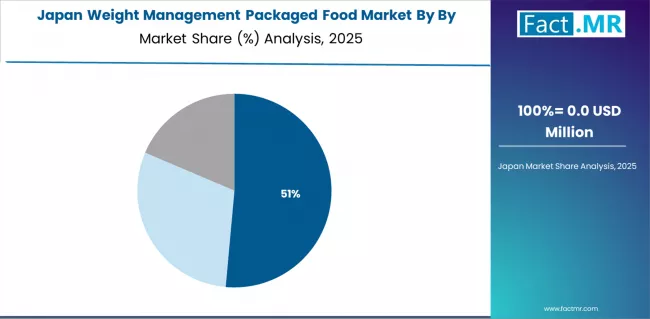
Japanese weight management packaged food operations reflect the country's exacting quality standards and sophisticated consumer requirements. Major food manufacturers and wellness companies maintain rigorous product development processes that often exceed international standards, requiring extensive nutritional validation, taste testing, and consumer acceptance studies that can take 12-18 months to complete. This creates high barriers for new suppliers but ensures consistent quality that supports premium consumer positioning.
The Japanese market demonstrates unique formulation requirements, with significant demand for ultra-precise nutritional specifications tailored to Japanese dietary preferences and wellness consciousness patterns. Companies require specific taste profiles and functional benefits that may differ from Western consumer preferences, driving demand for specialized product development capabilities.
Regulatory oversight through the Ministry of Health, Labour and Welfare emphasizes comprehensive safety management and health claim validation that surpass most international standards. The functional food approval system requires detailed clinical evidence and safety documentation, creating advantages for suppliers with robust research capabilities and comprehensive regulatory compliance.
Consumer engagement focuses on long-term wellness relationships rather than purely transactional purchasing patterns. Japanese consumers typically maintain brand loyalty spanning years, with product selection focusing quality consistency over price considerations. This stability supports investment in specialized weight management formulations tailored to Japanese consumer preferences.
Market Dynamics Drive Innovation in South Korea
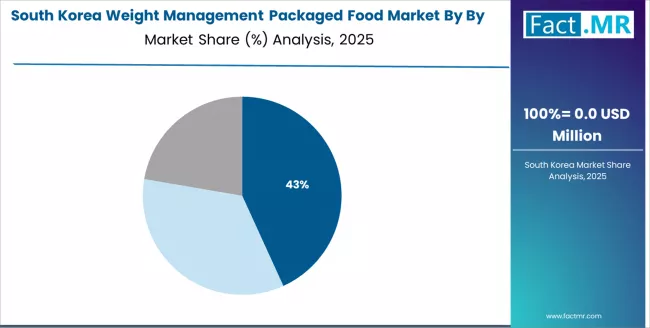
South Korean weight management packaged food operations reflect the country's advanced consumer market and health-oriented lifestyle model. Major food and wellness companies drive sophisticated product development strategies, establishing direct relationships with global suppliers to secure consistent quality and innovation for their health-focused operations targeting both domestic consumers and wellness export markets.
The Korean market demonstrates particular strength in applying nutrition technologies to weight management applications, with companies integrating functional ingredients and innovative delivery systems into products designed for busy urban lifestyles. This technological focus creates demand for specific product specifications that often exceed standard formulations, requiring suppliers to adapt nutritional profiles and convenience features.
Regulatory frameworks emphasize consumer safety and wellness innovation, with Korean Food and Drug Administration requirements often exceeding international benchmarks. This creates barriers for lower-quality suppliers but benefits established manufacturers who can demonstrate advanced capabilities. The regulatory environment particularly favors suppliers with functional ingredient validation and comprehensive safety documentation.
Consumer market efficiency remains critical given Korea's focus on lifestyle innovation and wellness trends. Companies increasingly pursue long-term contracts with suppliers in North America and Europe to ensure reliable access to high-quality ingredients while managing innovation transfer requirements. Advanced distribution investments support product preservation during international shipping and consumer education requirements.
Competitive Landscape of Weight Management Packaged Food Market
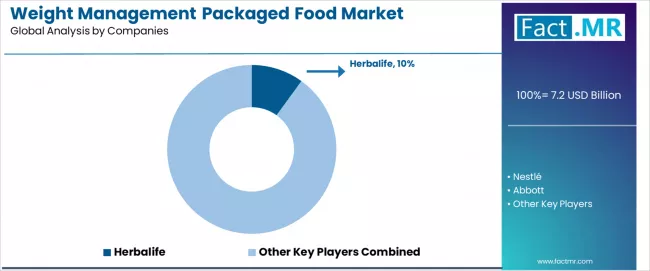
Profit pools are consolidating upstream in specialized nutrition manufacturing and downstream in comprehensive weight management solutions for retail, subscription, and clinical applications. Value is migrating from basic diet food manufacturing to specification-tight, clinically-validated products where effectiveness claims, taste optimization, and program integration command premiums. Several archetypes set the pace: global nutrition giants defending share through brand recognition and distribution scale; specialized weight management companies that focus on comprehensive lifestyle programs; functional food innovators with advanced formulation IP and clinical validation; and direct-to-consumer disruptors pulling value through personalized nutrition and subscription models.
Switching costs, program adherence, taste preferences, clinical validation, stabilize pricing for incumbents, while regulatory changes (health claim restrictions, clinical evidence requirements, labeling updates) and wellness trend shifts reopen share for innovative product developers. Consolidation and vertical integration continue; direct-to-consumer channels grow rapidly as retail presence remains brand-dependent. Market dynamics favor suppliers with comprehensive consumer insights, clinical validation capabilities, and established wellness industry relationships.
The competitive environment presents both opportunities and constraints. Advanced effectiveness requirements create barriers for generic food manufacturers but establish performance standards that favor established nutrition companies over commodity food producers. Market consolidation accelerates as companies seek economies of scale to absorb rising ingredient costs and clinical validation expenses.
| Stakeholder Type | Primary Advantage | Repeatable Plays |
|---|---|---|
| Global nutrition giants | Scale, brand recognition, distribution networks | Long-term retail partnerships, proven formulations, marketing expertise |
| Weight management specialists | Program focus, clinical validation | Structured programs, healthcare partnerships, effectiveness positioning |
| Functional food innovators | Advanced formulation IP and clinical validation | Nutritional science, ingredient innovation, health positioning |
| Direct-to-consumer disruptors | Personalization and subscription models | Digital marketing, customized nutrition, direct relationships |
Key Players in the Weight Management Packaged Food Market
- Herbalife
- Nestlé
- Abbott
- Glanbia
- SlimFast
- Huel
- Atkins
- Weight Watchers
- Premier Protein
- Atkins Nutritionals
Scope of the Report
| Items | Values |
|---|---|
| Quantitative Units | USD 7.2 billion |
| Product | Meal replacement bars/shakes, Low-calorie ready meals, Snacks |
| Claim | Clinically formulated, Functional/high-protein, Low-calorie |
| Regions Covered | North America, Latin America, Europe, Asia Pacific, Middle East & Africa |
| Country Covered | United States, Germany, France, Mexico, UK, and other 40+ countries |
| Key Companies Profiled | Herbalife, Nestlé, Abbott, Glanbia, SlimFast, Huel, Atkins, Weight Watchers, Premier Protein, Atkins Nutritionals |
| Additional Attributes | Dollar sales by product/claim/channel, regional demand (NA, EU, APAC), competitive landscape, personalized nutrition adoption, wellness program integration, and digital health technologies driving consumer engagement, effectiveness optimization, and lifestyle integration |
Weight Management Packaged Food Market Segmentation
-
By Product :
- Meal replacement bars/shakes
- Low-calorie ready meals
- Snacks
-
By Claim :
- Clinically formulated
- Functional/high-protein
- Low-calorie
-
By Channel :
- Retail
- Online subscription
- Clinical distribution
-
By Region :
- North America
- Europe
- Asia Pacific
- Latin America
- Middle East & Africa
Table of Content
- Executive Summary
- Global Market Outlook
- Demand to side Trends
- Supply to side Trends
- Technology Roadmap Analysis
- Analysis and Recommendations
- Market Overview
- Market Coverage / Taxonomy
- Market Definition / Scope / Limitations
- Market Background
- Market Dynamics
- Drivers
- Restraints
- Opportunity
- Trends
- Scenario Forecast
- Demand in Optimistic Scenario
- Demand in Likely Scenario
- Demand in Conservative Scenario
- Opportunity Map Analysis
- Product Life Cycle Analysis
- Supply Chain Analysis
- Investment Feasibility Matrix
- Value Chain Analysis
- PESTLE and Porter’s Analysis
- Regulatory Landscape
- Regional Parent Market Outlook
- Production and Consumption Statistics
- Import and Export Statistics
- Market Dynamics
- Global Market Analysis 2020 to 2024 and Forecast, 2025 to 2035
- Historical Market Size Value (USD Million) Analysis, 2020 to 2024
- Current and Future Market Size Value (USD Million) Projections, 2025 to 2035
- Y to o to Y Growth Trend Analysis
- Absolute $ Opportunity Analysis
- Global Market Pricing Analysis 2020 to 2024 and Forecast 2025 to 2035
- Global Market Analysis 2020 to 2024 and Forecast 2025 to 2035, By By Product
- Introduction / Key Findings
- Historical Market Size Value (USD Million) Analysis By By Product , 2020 to 2024
- Current and Future Market Size Value (USD Million) Analysis and Forecast By By Product , 2025 to 2035
- Meal replacement bars/shakes
- Low-calorie ready meals
- Snacks
- Y to o to Y Growth Trend Analysis By By Product , 2020 to 2024
- Absolute $ Opportunity Analysis By By Product , 2025 to 2035
- Global Market Analysis 2020 to 2024 and Forecast 2025 to 2035, By By Claim
- Introduction / Key Findings
- Historical Market Size Value (USD Million) Analysis By By Claim, 2020 to 2024
- Current and Future Market Size Value (USD Million) Analysis and Forecast By By Claim, 2025 to 2035
- Functional/high-protein
- Low-calorie
- Clinically formulated
- Y to o to Y Growth Trend Analysis By By Claim, 2020 to 2024
- Absolute $ Opportunity Analysis By By Claim, 2025 to 2035
- Global Market Analysis 2020 to 2024 and Forecast 2025 to 2035, By By Channel
- Introduction / Key Findings
- Historical Market Size Value (USD Million) Analysis By By Channel, 2020 to 2024
- Current and Future Market Size Value (USD Million) Analysis and Forecast By By Channel, 2025 to 2035
- Retail
- Online subscription
- Clinical distribution
- Y to o to Y Growth Trend Analysis By By Channel, 2020 to 2024
- Absolute $ Opportunity Analysis By By Channel, 2025 to 2035
- Global Market Analysis 2020 to 2024 and Forecast 2025 to 2035, By Region
- Introduction
- Historical Market Size Value (USD Million) Analysis By Region, 2020 to 2024
- Current Market Size Value (USD Million) Analysis and Forecast By Region, 2025 to 2035
- North America
- Latin America
- Western Europe
- Eastern Europe
- East Asia
- South Asia and Pacific
- Middle East & Africa
- Market Attractiveness Analysis By Region
- North America Market Analysis 2020 to 2024 and Forecast 2025 to 2035, By Country
- Historical Market Size Value (USD Million) Trend Analysis By Market Taxonomy, 2020 to 2024
- Market Size Value (USD Million) Forecast By Market Taxonomy, 2025 to 2035
- By Country
- USA
- Canada
- Mexico
- By By Product
- By By Claim
- By By Channel
- By Country
- Market Attractiveness Analysis
- By Country
- By By Product
- By By Claim
- By By Channel
- Key Takeaways
- Latin America Market Analysis 2020 to 2024 and Forecast 2025 to 2035, By Country
- Historical Market Size Value (USD Million) Trend Analysis By Market Taxonomy, 2020 to 2024
- Market Size Value (USD Million) Forecast By Market Taxonomy, 2025 to 2035
- By Country
- Brazil
- Chile
- Rest of Latin America
- By By Product
- By By Claim
- By By Channel
- By Country
- Market Attractiveness Analysis
- By Country
- By By Product
- By By Claim
- By By Channel
- Key Takeaways
- Western Europe Market Analysis 2020 to 2024 and Forecast 2025 to 2035, By Country
- Historical Market Size Value (USD Million) Trend Analysis By Market Taxonomy, 2020 to 2024
- Market Size Value (USD Million) Forecast By Market Taxonomy, 2025 to 2035
- By Country
- Germany
- UK
- Italy
- Spain
- France
- Nordic
- BENELUX
- Rest of Western Europe
- By By Product
- By By Claim
- By By Channel
- By Country
- Market Attractiveness Analysis
- By Country
- By By Product
- By By Claim
- By By Channel
- Key Takeaways
- Eastern Europe Market Analysis 2020 to 2024 and Forecast 2025 to 2035, By Country
- Historical Market Size Value (USD Million) Trend Analysis By Market Taxonomy, 2020 to 2024
- Market Size Value (USD Million) Forecast By Market Taxonomy, 2025 to 2035
- By Country
- Russia
- Poland
- Hungary
- Balkan & Baltic
- Rest of Eastern Europe
- By By Product
- By By Claim
- By By Channel
- By Country
- Market Attractiveness Analysis
- By Country
- By By Product
- By By Claim
- By By Channel
- Key Takeaways
- East Asia Market Analysis 2020 to 2024 and Forecast 2025 to 2035, By Country
- Historical Market Size Value (USD Million) Trend Analysis By Market Taxonomy, 2020 to 2024
- Market Size Value (USD Million) Forecast By Market Taxonomy, 2025 to 2035
- By Country
- China
- Japan
- South Korea
- By By Product
- By By Claim
- By By Channel
- By Country
- Market Attractiveness Analysis
- By Country
- By By Product
- By By Claim
- By By Channel
- Key Takeaways
- South Asia and Pacific Market Analysis 2020 to 2024 and Forecast 2025 to 2035, By Country
- Historical Market Size Value (USD Million) Trend Analysis By Market Taxonomy, 2020 to 2024
- Market Size Value (USD Million) Forecast By Market Taxonomy, 2025 to 2035
- By Country
- India
- ASEAN
- Australia & New Zealand
- Rest of South Asia and Pacific
- By By Product
- By By Claim
- By By Channel
- By Country
- Market Attractiveness Analysis
- By Country
- By By Product
- By By Claim
- By By Channel
- Key Takeaways
- Middle East & Africa Market Analysis 2020 to 2024 and Forecast 2025 to 2035, By Country
- Historical Market Size Value (USD Million) Trend Analysis By Market Taxonomy, 2020 to 2024
- Market Size Value (USD Million) Forecast By Market Taxonomy, 2025 to 2035
- By Country
- Kingdom of Saudi Arabia
- Other GCC Countries
- Turkiye
- South Africa
- Other African Union
- Rest of Middle East & Africa
- By By Product
- By By Claim
- By By Channel
- By Country
- Market Attractiveness Analysis
- By Country
- By By Product
- By By Claim
- By By Channel
- Key Takeaways
- Key Countries Market Analysis
- USA
- Pricing Analysis
- Market Share Analysis, 2024
- By By Product
- By By Claim
- By By Channel
- Canada
- Pricing Analysis
- Market Share Analysis, 2024
- By By Product
- By By Claim
- By By Channel
- Mexico
- Pricing Analysis
- Market Share Analysis, 2024
- By By Product
- By By Claim
- By By Channel
- Brazil
- Pricing Analysis
- Market Share Analysis, 2024
- By By Product
- By By Claim
- By By Channel
- Chile
- Pricing Analysis
- Market Share Analysis, 2024
- By By Product
- By By Claim
- By By Channel
- Germany
- Pricing Analysis
- Market Share Analysis, 2024
- By By Product
- By By Claim
- By By Channel
- UK
- Pricing Analysis
- Market Share Analysis, 2024
- By By Product
- By By Claim
- By By Channel
- Italy
- Pricing Analysis
- Market Share Analysis, 2024
- By By Product
- By By Claim
- By By Channel
- Spain
- Pricing Analysis
- Market Share Analysis, 2024
- By By Product
- By By Claim
- By By Channel
- France
- Pricing Analysis
- Market Share Analysis, 2024
- By By Product
- By By Claim
- By By Channel
- India
- Pricing Analysis
- Market Share Analysis, 2024
- By By Product
- By By Claim
- By By Channel
- ASEAN
- Pricing Analysis
- Market Share Analysis, 2024
- By By Product
- By By Claim
- By By Channel
- Australia & New Zealand
- Pricing Analysis
- Market Share Analysis, 2024
- By By Product
- By By Claim
- By By Channel
- China
- Pricing Analysis
- Market Share Analysis, 2024
- By By Product
- By By Claim
- By By Channel
- Japan
- Pricing Analysis
- Market Share Analysis, 2024
- By By Product
- By By Claim
- By By Channel
- South Korea
- Pricing Analysis
- Market Share Analysis, 2024
- By By Product
- By By Claim
- By By Channel
- Russia
- Pricing Analysis
- Market Share Analysis, 2024
- By By Product
- By By Claim
- By By Channel
- Poland
- Pricing Analysis
- Market Share Analysis, 2024
- By By Product
- By By Claim
- By By Channel
- Hungary
- Pricing Analysis
- Market Share Analysis, 2024
- By By Product
- By By Claim
- By By Channel
- Kingdom of Saudi Arabia
- Pricing Analysis
- Market Share Analysis, 2024
- By By Product
- By By Claim
- By By Channel
- Turkiye
- Pricing Analysis
- Market Share Analysis, 2024
- By By Product
- By By Claim
- By By Channel
- South Africa
- Pricing Analysis
- Market Share Analysis, 2024
- By By Product
- By By Claim
- By By Channel
- USA
- Market Structure Analysis
- Competition Dashboard
- Competition Benchmarking
- Market Share Analysis of Top Players
- By Regional
- By By Product
- By By Claim
- By By Channel
- Competition Analysis
- Competition Deep Dive
- Herbalife
- Overview
- Product Portfolio
- Profitability by Market Segments (Product/Age /Sales Channel/Region)
- Sales Footprint
- Strategy Overview
- Marketing Strategy
- Product Strategy
- Channel Strategy
- Nestlé
- Abbott
- Glanbia
- SlimFast
- Huel
- Atkins
- Weight Watchers
- Premier Protein
- Atkins Nutritionals
- Herbalife
- Competition Deep Dive
- Assumptions & Acronyms Used
- Research Methodology
List Of Table
- Table 1: Global Market Value (USD Million) Forecast by Region, 2020 to 2035
- Table 2: Global Market Value (USD Million) Forecast by By Product , 2020 to 2035
- Table 3: Global Market Value (USD Million) Forecast by By Claim, 2020 to 2035
- Table 4: Global Market Value (USD Million) Forecast by By Channel, 2020 to 2035
- Table 5: North America Market Value (USD Million) Forecast by Country, 2020 to 2035
- Table 6: North America Market Value (USD Million) Forecast by By Product , 2020 to 2035
- Table 7: North America Market Value (USD Million) Forecast by By Claim, 2020 to 2035
- Table 8: North America Market Value (USD Million) Forecast by By Channel, 2020 to 2035
- Table 9: Latin America Market Value (USD Million) Forecast by Country, 2020 to 2035
- Table 10: Latin America Market Value (USD Million) Forecast by By Product , 2020 to 2035
- Table 11: Latin America Market Value (USD Million) Forecast by By Claim, 2020 to 2035
- Table 12: Latin America Market Value (USD Million) Forecast by By Channel, 2020 to 2035
- Table 13: Western Europe Market Value (USD Million) Forecast by Country, 2020 to 2035
- Table 14: Western Europe Market Value (USD Million) Forecast by By Product , 2020 to 2035
- Table 15: Western Europe Market Value (USD Million) Forecast by By Claim, 2020 to 2035
- Table 16: Western Europe Market Value (USD Million) Forecast by By Channel, 2020 to 2035
- Table 17: Eastern Europe Market Value (USD Million) Forecast by Country, 2020 to 2035
- Table 18: Eastern Europe Market Value (USD Million) Forecast by By Product , 2020 to 2035
- Table 19: Eastern Europe Market Value (USD Million) Forecast by By Claim, 2020 to 2035
- Table 20: Eastern Europe Market Value (USD Million) Forecast by By Channel, 2020 to 2035
- Table 21: East Asia Market Value (USD Million) Forecast by Country, 2020 to 2035
- Table 22: East Asia Market Value (USD Million) Forecast by By Product , 2020 to 2035
- Table 23: East Asia Market Value (USD Million) Forecast by By Claim, 2020 to 2035
- Table 24: East Asia Market Value (USD Million) Forecast by By Channel, 2020 to 2035
- Table 25: South Asia and Pacific Market Value (USD Million) Forecast by Country, 2020 to 2035
- Table 26: South Asia and Pacific Market Value (USD Million) Forecast by By Product , 2020 to 2035
- Table 27: South Asia and Pacific Market Value (USD Million) Forecast by By Claim, 2020 to 2035
- Table 28: South Asia and Pacific Market Value (USD Million) Forecast by By Channel, 2020 to 2035
- Table 29: Middle East & Africa Market Value (USD Million) Forecast by Country, 2020 to 2035
- Table 30: Middle East & Africa Market Value (USD Million) Forecast by By Product , 2020 to 2035
- Table 31: Middle East & Africa Market Value (USD Million) Forecast by By Claim, 2020 to 2035
- Table 32: Middle East & Africa Market Value (USD Million) Forecast by By Channel, 2020 to 2035
List Of Figures
- Figure 1: Global Market Pricing Analysis
- Figure 2: Global Market Value (USD Million) Forecast 2020-2035
- Figure 3: Global Market Value Share and BPS Analysis by By Product , 2025 and 2035
- Figure 4: Global Market Y to o to Y Growth Comparison by By Product , 2025-2035
- Figure 5: Global Market Attractiveness Analysis by By Product
- Figure 6: Global Market Value Share and BPS Analysis by By Claim, 2025 and 2035
- Figure 7: Global Market Y to o to Y Growth Comparison by By Claim, 2025-2035
- Figure 8: Global Market Attractiveness Analysis by By Claim
- Figure 9: Global Market Value Share and BPS Analysis by By Channel, 2025 and 2035
- Figure 10: Global Market Y to o to Y Growth Comparison by By Channel, 2025-2035
- Figure 11: Global Market Attractiveness Analysis by By Channel
- Figure 12: Global Market Value (USD Million) Share and BPS Analysis by Region, 2025 and 2035
- Figure 13: Global Market Y to o to Y Growth Comparison by Region, 2025-2035
- Figure 14: Global Market Attractiveness Analysis by Region
- Figure 15: North America Market Incremental Dollar Opportunity, 2025-2035
- Figure 16: Latin America Market Incremental Dollar Opportunity, 2025-2035
- Figure 17: Western Europe Market Incremental Dollar Opportunity, 2025-2035
- Figure 18: Eastern Europe Market Incremental Dollar Opportunity, 2025-2035
- Figure 19: East Asia Market Incremental Dollar Opportunity, 2025-2035
- Figure 20: South Asia and Pacific Market Incremental Dollar Opportunity, 2025-2035
- Figure 21: Middle East & Africa Market Incremental Dollar Opportunity, 2025-2035
- Figure 22: North America Market Value Share and BPS Analysis by Country, 2025 and 2035
- Figure 23: North America Market Value Share and BPS Analysis by By Product , 2025 and 2035
- Figure 24: North America Market Y to o to Y Growth Comparison by By Product , 2025-2035
- Figure 25: North America Market Attractiveness Analysis by By Product
- Figure 26: North America Market Value Share and BPS Analysis by By Claim, 2025 and 2035
- Figure 27: North America Market Y to o to Y Growth Comparison by By Claim, 2025-2035
- Figure 28: North America Market Attractiveness Analysis by By Claim
- Figure 29: North America Market Value Share and BPS Analysis by By Channel, 2025 and 2035
- Figure 30: North America Market Y to o to Y Growth Comparison by By Channel, 2025-2035
- Figure 31: North America Market Attractiveness Analysis by By Channel
- Figure 32: Latin America Market Value Share and BPS Analysis by Country, 2025 and 2035
- Figure 33: Latin America Market Value Share and BPS Analysis by By Product , 2025 and 2035
- Figure 34: Latin America Market Y to o to Y Growth Comparison by By Product , 2025-2035
- Figure 35: Latin America Market Attractiveness Analysis by By Product
- Figure 36: Latin America Market Value Share and BPS Analysis by By Claim, 2025 and 2035
- Figure 37: Latin America Market Y to o to Y Growth Comparison by By Claim, 2025-2035
- Figure 38: Latin America Market Attractiveness Analysis by By Claim
- Figure 39: Latin America Market Value Share and BPS Analysis by By Channel, 2025 and 2035
- Figure 40: Latin America Market Y to o to Y Growth Comparison by By Channel, 2025-2035
- Figure 41: Latin America Market Attractiveness Analysis by By Channel
- Figure 42: Western Europe Market Value Share and BPS Analysis by Country, 2025 and 2035
- Figure 43: Western Europe Market Value Share and BPS Analysis by By Product , 2025 and 2035
- Figure 44: Western Europe Market Y to o to Y Growth Comparison by By Product , 2025-2035
- Figure 45: Western Europe Market Attractiveness Analysis by By Product
- Figure 46: Western Europe Market Value Share and BPS Analysis by By Claim, 2025 and 2035
- Figure 47: Western Europe Market Y to o to Y Growth Comparison by By Claim, 2025-2035
- Figure 48: Western Europe Market Attractiveness Analysis by By Claim
- Figure 49: Western Europe Market Value Share and BPS Analysis by By Channel, 2025 and 2035
- Figure 50: Western Europe Market Y to o to Y Growth Comparison by By Channel, 2025-2035
- Figure 51: Western Europe Market Attractiveness Analysis by By Channel
- Figure 52: Eastern Europe Market Value Share and BPS Analysis by Country, 2025 and 2035
- Figure 53: Eastern Europe Market Value Share and BPS Analysis by By Product , 2025 and 2035
- Figure 54: Eastern Europe Market Y to o to Y Growth Comparison by By Product , 2025-2035
- Figure 55: Eastern Europe Market Attractiveness Analysis by By Product
- Figure 56: Eastern Europe Market Value Share and BPS Analysis by By Claim, 2025 and 2035
- Figure 57: Eastern Europe Market Y to o to Y Growth Comparison by By Claim, 2025-2035
- Figure 58: Eastern Europe Market Attractiveness Analysis by By Claim
- Figure 59: Eastern Europe Market Value Share and BPS Analysis by By Channel, 2025 and 2035
- Figure 60: Eastern Europe Market Y to o to Y Growth Comparison by By Channel, 2025-2035
- Figure 61: Eastern Europe Market Attractiveness Analysis by By Channel
- Figure 62: East Asia Market Value Share and BPS Analysis by Country, 2025 and 2035
- Figure 63: East Asia Market Value Share and BPS Analysis by By Product , 2025 and 2035
- Figure 64: East Asia Market Y to o to Y Growth Comparison by By Product , 2025-2035
- Figure 65: East Asia Market Attractiveness Analysis by By Product
- Figure 66: East Asia Market Value Share and BPS Analysis by By Claim, 2025 and 2035
- Figure 67: East Asia Market Y to o to Y Growth Comparison by By Claim, 2025-2035
- Figure 68: East Asia Market Attractiveness Analysis by By Claim
- Figure 69: East Asia Market Value Share and BPS Analysis by By Channel, 2025 and 2035
- Figure 70: East Asia Market Y to o to Y Growth Comparison by By Channel, 2025-2035
- Figure 71: East Asia Market Attractiveness Analysis by By Channel
- Figure 72: South Asia and Pacific Market Value Share and BPS Analysis by Country, 2025 and 2035
- Figure 73: South Asia and Pacific Market Value Share and BPS Analysis by By Product , 2025 and 2035
- Figure 74: South Asia and Pacific Market Y to o to Y Growth Comparison by By Product , 2025-2035
- Figure 75: South Asia and Pacific Market Attractiveness Analysis by By Product
- Figure 76: South Asia and Pacific Market Value Share and BPS Analysis by By Claim, 2025 and 2035
- Figure 77: South Asia and Pacific Market Y to o to Y Growth Comparison by By Claim, 2025-2035
- Figure 78: South Asia and Pacific Market Attractiveness Analysis by By Claim
- Figure 79: South Asia and Pacific Market Value Share and BPS Analysis by By Channel, 2025 and 2035
- Figure 80: South Asia and Pacific Market Y to o to Y Growth Comparison by By Channel, 2025-2035
- Figure 81: South Asia and Pacific Market Attractiveness Analysis by By Channel
- Figure 82: Middle East & Africa Market Value Share and BPS Analysis by Country, 2025 and 2035
- Figure 83: Middle East & Africa Market Value Share and BPS Analysis by By Product , 2025 and 2035
- Figure 84: Middle East & Africa Market Y to o to Y Growth Comparison by By Product , 2025-2035
- Figure 85: Middle East & Africa Market Attractiveness Analysis by By Product
- Figure 86: Middle East & Africa Market Value Share and BPS Analysis by By Claim, 2025 and 2035
- Figure 87: Middle East & Africa Market Y to o to Y Growth Comparison by By Claim, 2025-2035
- Figure 88: Middle East & Africa Market Attractiveness Analysis by By Claim
- Figure 89: Middle East & Africa Market Value Share and BPS Analysis by By Channel, 2025 and 2035
- Figure 90: Middle East & Africa Market Y to o to Y Growth Comparison by By Channel, 2025-2035
- Figure 91: Middle East & Africa Market Attractiveness Analysis by By Channel
- Figure 92: Global Market - Tier Structure Analysis
- Figure 93: Global Market - Company Share Analysis
- FAQs -
How big is the weight management packaged food market in 2025?
The global weight management packaged food market is estimated to be valued at USD 7.2 billion in 2025.
What will be the size of weight management packaged food market in 2035?
The market size for the weight management packaged food market is projected to reach USD 12.6 billion by 2035.
How much will be the weight management packaged food market growth between 2025 and 2035?
The weight management packaged food market is expected to grow at a 5.9% CAGR between 2025 and 2035.
What are the key product types in the weight management packaged food market?
The key product types in weight management packaged food market are meal replacement bars/shakes, low-calorie ready meals and snacks.
Which by claim segment to contribute significant share in the weight management packaged food market in 2025?
In terms of by claim, functional/high-protein segment to command 42.0% share in the weight management packaged food market in 2025.